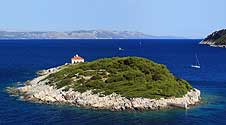National parks and nature parks are
usually examples of larger protected areas, however there are also
numerous ''miniatures'' which were also formed by the activity of
natural forces, without any human intervention. Volcanic eruptions,
windblown deposits, rise of Earth's crust and river flows have created
fascinating landscapes which indicate how old our planet really is and
how important it is to protect it.
Croatia has a great number of those ''miniatures'': 120 horticultural locations, 75 natural phenomena, 73 special reserves, 28 significant landscapes, 27 park-forests etc.
We present you with only a few of them:Croatia has a great number of those ''miniatures'': 120 horticultural locations, 75 natural phenomena, 73 special reserves, 28 significant landscapes, 27 park-forests etc.
- Golden Cape (Zlatni rat) – one of the most popular beaches along the Adriatic is located in Bol, on the island of Brač. The shape of this pebble beach changes along with the changes in tide, currents and wind.
- Blue Grotto (Modra špilja) – is a sea cave on the island of Biševo, located close to Vis Island. It was named after special blue light which is created in it by sunlight rays reflecting on the sandy bottom. It is often compared with the famous Italian counterpart on the island of Capri.
- Lim Bay (Limski zaljev) – is a deep picturesque sea bay located on the western coast of Istria. It is very narrow, with steep sides, due to which it is often compared to Norwegian fjords.
- Blue and Red Lake (Modro i Crveno jezero) – these lakes located in Imotski, a place in Dalmatian hinterland, are considered to be special karst phenomena. They were formed by the collapse of huge underground caves and named after their seemingly red and blue lake waters.
- Volcanic islands Jabuka and Brusnik – being formed in a volcanic eruption these small islands located nearby Vis Island have a completely different formation stories when compared to the other islands in the Adriatic. The islands are famous for their endemic species and flora and fauna which evolved due to the special soil and environment.
- Cerovac Caves (Cerovačke špilje) – this over 4 kilometers long speleological system is located in Velebit Nature park. One of its most interesting features are the rocks shaped by cave bears – namely their surface was shaped by the passing of bears through the caves' narrow hallways.
- Kolač – this natural phenomenon is actually a big rock nearby Nerežišće, on the island of Brač. Shaped as a ring or arch, it reminded many of a cake and was therefore given this interesting name – Kolač – which is the Croatian word for cake.












